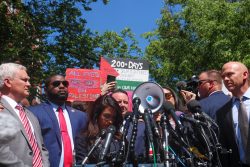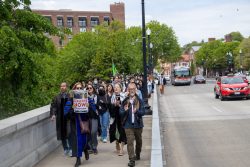My guess is that in the four years I’ve been here, at least 900 people in the District have been murdered. In the first three months of this year, there have been over 50 homicides, up 13 percent from the same time last year. Among the recent victims:
Saturday, March 23: Corey Harvell, 24, died from a gunshot wound to the head in Southeast.
Sunday, March 24: Benita Morgan, 21, died from gunshot wounds. She was found in an alley off 16th Street, N.W. Police have arrested an 18-year-old, Michael Lamont Blyther, in the case.
Tuesday, March 26: Markita Lee, 22, was found on the sidewalk in the 1600 block of V Street, S.E. She died from a gunshot wound to the back.
There have been other deaths. In March alone, there were four gang-related drive-bys that claimed four lives and injured a dozen. One 16-year-old girl in Northwest is lucky to be alive, but the man police believe shot her in the neck is still at large.
And while police have made some recent arrests in homicide cases, half of murders go unsolved.
It’s not hard to understand, then, why there is considerable doubt that the inner-city can really be “developed.”And yet that doubt is dangerous. It can cripple public policy and make it easier for politicians to elevate other issues, not worth the newspaper they’re printed on, to heights of uncommon importance.
Consider this case: Not too long ago, Mayor Anthony Williams thought the District should spend $1 million on security at the MCI center for the would-be Mike Tyson-Lennox Lewis fight. The boxers have since skipped town to collect a $12.5 million site fee from the city of Memphis. But it is outrageous that Williams wanted to spend $1 million on a fight that would have added at most a measely 0.01 percent to our District-wide gross income, when that money could be better spent on police officers, reconstruction of schools, and gang prevention and reduction measures, such as after-school programs and recruitment of talented principals and counselors.
But will these policies ever work? Indeed, they can. One Washington Post columnist tells the story of Lincoln Middle School in Columbia Heights: a poor District school infested with guns and gangs in the 1990s. A former correctional officer was brought in as principal and through a remarkably common-sensical agenda of security measures?surprise locker checks, mental detectors?and after-school programs, Principal Enrique Watson had the rival gang members breaking bread together.
I do not mean to trivialize the problem. However, at the same time, it sounds like there are people and programs who can deal rather effectively with gang activity. That’s for a reason: There are.
What matters is the extent to which a city commits itself to deal with it. Keep that in mind as the D.C. Council and Williams argue over the mayor’s proposed budget in the next few weeks. Several members of the council will want to continue the scheduled reductions in the District’s income tax, even though upper-income residents will receive more from the cut as a percentage of their income than moderate income earners. When it comes to the corporate income tax, everyone seems to agree that the reductions should continue, presumably in order to attract firms to the District. But those firms certainly aren’t going to employ the youth in Garfield Terrace or Georgia Avenue, home to the recent violence.
We should make it clear that those youth are our priority. And we should be abundantly clear that we will hold our leaders accountable for results, not just how much they spend. A liberal government need not be a dumb, bloated or mismanaged one, just like your four years here need not be characterized by the loss of young life all around you.




